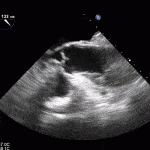Introduction
- Tear in the aortic intima that results in blood entering the media layer of the aorta.
- Variants include intramural hematoma, penetrating ulcer, traumatic/Iatrogenic.
- Often classified by Stanford Classification:
- Type A: This involves the ascending aorta and is a surgical emergency.
- Type B: No involvement of ascending aorta and is usually treated medically.
Risk Factors
- Marfan’s syndrome
- Vascular Ehlers-Danlos syndrome
- Annuloaortic ectasia
- Bicuspid Aortic Valve
- Familial Aortic Dissection
- HTN
- Atherosclerosis
- Cardiac Surgery
- Decel Time (MVA)
Presentation
- Acute onset, severe, tearing, chest pain.
- Blood pressure differential between arms.
- Chest pain with stroke symptoms -> Dissection until proven otherwise.
- Can present as mimics: STEMI, valvular disease (AR), tamponade, syncope, stroke, renal failure, limb ischemia, spinal cord injury
Diagnosis
ECG
- Usually will have non-specific ST or T wave changes.
- May have ischemia type changes including ST elevation.
- Patients can present as Inferior STEMI’s for two reasons. The first is a dissection is more likely to occur in the greater curvature and thus more likely to obstruct the RCA. Second Dissection into the left main is often fatal.
CXR
- May have findings such as a wide mediastinum.
- Trachea may be displaced because of the enlarging aorta.
TTE
- Not sensitive enough to rule out aortic dissection.
- Hallmark of dissection is presence of a dissection flap this can sometimes be seen on TTE.
- May also see an enlarge aorta.
- Aortic regurgitation frequently accompanies a dissection.
- Pericardial effusion in particular bloody effusion may be suggestive that the dissection has migrated into the pericardium.
TEE
- Sensitive test to rule out aortic dissection 95-100%.
- Artifacts may mimic dissection flaps.
- There is a “blind spot” on TEE between the interposition of the trachea and ascending aorta.
CT (First Line)
- Widely available test than is usually first line in the assessment of aortic dissection.
- Allows assessment of other vascular beds involved in dissection and complications.
Cardiac Catheterization
JAMA
| Focal neuro deficit (LR+ 6.6-33) |
| Pulse deficit/differential BP (LR+5.7) |
| Enlarged aorta or mediastinum on CXR (LR+ 2.0) |
Treatment
- Treat pain aggressively with narcotics.
- Anti-Impulse therapy: Use IV beta-blockers or calcium channel blocker. These medications reduce blood pressure and left ventricular contraction = less shear wall stress of aorta and reduces dissection propagation.Target a heart rate of < 60 and a systolic blood pressure between 100-120 mmHg. IV Esmolol or Labetalol is a good option as short half life in case hemodynamics change.
- Afterload reduction (If still Hypertensive): Nitroprusside a good option is patient still hypertensive. Do NOT use without a beta-blockers or calcium channel blockers on board as vasodilation will lead to reflex tachycardia which may increase left ventricular contraction and worsen dissection.
- Surgical consultation. Type A dissection is a surgical emergency need immediate OR. Untreated type A dissection have a 50% mortality! Type B dissection can be managed medically especially if no other end-organ damage.
- If hemodynamically unstable consider pericardiocentesis.
A Word On Pericardiocentesis:
- Cardiac Tamponade is a leading cause of death in aortic dissection patients.
- There is controversy on performing a pericardiocentesis in aortic dissection patients with hemopericadium (concern that performing this procudere would dislodge a clot and worsen leak from aorta into pericardium).
- However, if unstable should consider “Controlled Pericardial Drainage” which is removal of small volumes of pericardial fluid (10ml at a time) to restore hemodynamics as a bridge to get the patient to the OR.
- ESC supports this “In the setting of aortic dissection with haemopericardium, controlled pericardial drainage of very small amounts of the haemopericardium should be considered to temporarily stabilize the patient in order to maintain blood pressure at about 90 mmHg” (Class IIa recommendation)
References
- Up-to-date.
- Cardiac tamponade due to aortic dissection: clinical picture and treatment with a focus on pericardiocentesis. https://www.escardio.org/Journals/E-Journal-of-Cardiology-Practice/Volume-15/Cardiac-tamponade-due-to-aortic-dissection-clinical-picture-and-treatment-with-focus-on-pericardiocentesis.
- 2015 ESC Guidelines for the Diagnosis and Management of Pericardial Diseases (html) (pdf)
- Ranasinghe AM, Strong D, Boland B, Bonser RS. Acute aortic dissection. BMJ (Clinical research ed.). 2011; 343:d4487.
Authors
- Authors: Dr. Daniel Durocher (MD, FRCPC, Cardiologist and ICU Fellow)
- Staff Reviewer: TBD
- Last Updated: August 26, 2021
- Comments or questions please email feedback@cardioguide.ca









